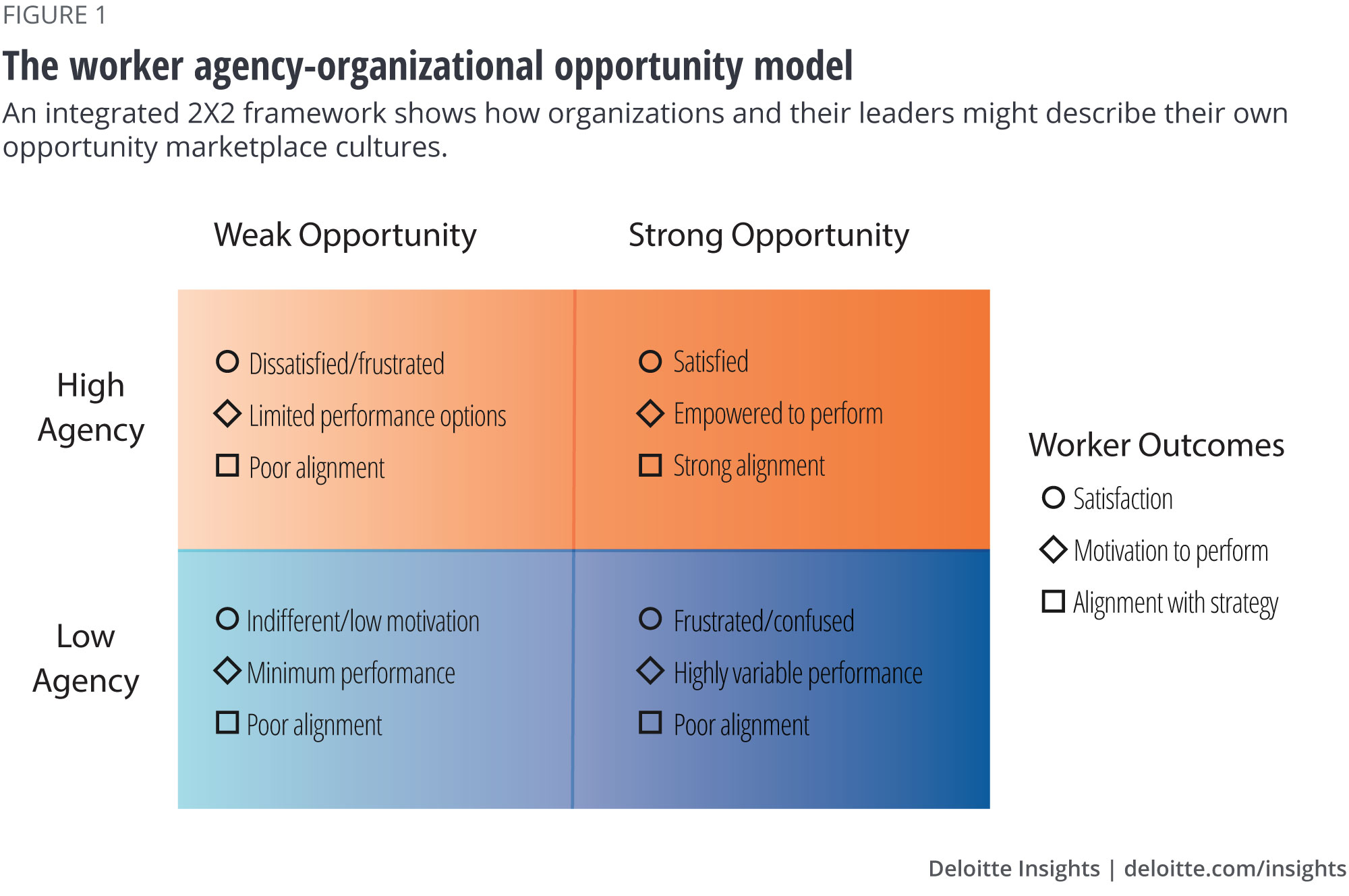
Create a crisis growth plan Start with opportunity marketplaces
9 minute read
23 June 2020
 David Kiron United States
David Kiron United States Jeff Schwartz United States
Jeff Schwartz United States Robin Jones United States
Robin Jones United States Natasha Buckley United States
Natasha Buckley United States
Learn how opportunity marketplaces are helping unlock the agility businesses need to meet COVID-19-related challenges, build value, and prepare for future growth.
The COVID-19 pandemic has completely disrupted how most global enterprises operate. With new priorities comes an urgent and strategically important challenge: ensuring that enough of the right people are working on the right opportunities at the right time, all while operating in an investment-constrained environment. Organizations should have visibility into their workforce capabilities and deployments to make informed decisions about how to optimally allocate their workforces.
Based on recently released research on opportunity marketplaces,1 we contend that market mechanisms can be a faster and more effective way to address this challenge than traditional workforce planning and deployment methods. There is evidence of organizations using marketplaces to accelerate the redeployment of employees and workers to business-critical roles and projects in a variety of industries and circumstances. These marketplaces can also have a beneficial effect on workers: They can sustain employment, reveal untapped worker capabilities, and motivate workers in new ways.
What Is an Opportunity Marketplace?
MIT Sloan Management Review and Deloitte’s 2020 research collaboration identifies the growing use of opportunity marketplaces — systems and platforms that enable talent to access strategically valuable opportunities while building skills and capabilities for themselves. Markets that facilitate successful exchanges between organizations and their workers around defined opportunities tend to efficiently and fairly allocate talent.
These markets empower and encourage workers to evaluate, choose, and act on opportunities that are important for the organization and for themselves. In turn, opportunity marketplaces can provide an organization with actionable data and analytics, which can help it become more efficient, valuable, and productive.
Like any fairly designed market, opportunity marketplaces are about mutual gain.
Learn More
Read our related research
Dig into the data using the interactive dashboard
Explore the Future of Work collection
Learn about Deloitte's services
Go straight to smart. Get the Deloitte Insights app
Schneider Electric is a case in point. In 2018, the company created a platform-based open talent market, in part to retain workers: Managers listed opportunities for side projects, training, and mentoring, and workers pursued those opportunities according to their interests and availability. When the pandemic started, Schneider’s marketplace became essential to getting work done. “We’re relying tremendously on our open talent markets,” says Andrew Saidy, vice president of talent digitization. “The pace of employee registrations we’re seeing is unprecedented; more projects are being posted. With the crisis, you have budget cuts here, you have roles being frozen there. But managers still have projects that they need to deliver, so they need helping hands.” Schneider also encouraged managers to split positions affected by a hiring freeze into different projects and post them on the exchange, offering more opportunities to more workers.
Henry Ford Health System is building a talent market to shift capacity from the local hospital level to a cross-system network level. The Michigan-based health care provider is composed of six hospitals, multiple ambulatory sites, and clinics. Pre-COVID-19, office staffing occurred locally rather than centrally. If someone in a given hospital called in sick, someone else within that hospital would fill in. Now, with staffing needs exceeding the capacity of any one hospital or clinic, Henry Ford developed a centralized staffing command center. If a talent need can’t be met at the local level, the request is moved to the Flexible Staffing Command Center where the need can be addressed across the health system or in some cases externally via collaboration with outside partners. The command center is a platform that connects to the company’s human resource management system, enabling managers to request resources or note staff as available. Those who participate complete a profile with background information on their skills, including the languages they speak and licenses they hold, to help managers assess their fit for specific roles. Ultimately, this has increased business leaders’ access to more resources and people, and workers have had more opportunities for work.
In this pandemic market environment, opportunity marketplaces represent a step change in companies’ ability to efficiently and effectively match labor with tasks.
Our report, “Opportunity Marketplaces: Aligning Workforce Investment and Value Creation in the Digital Enterprise,” shows that such digital platforms can improve data-driven decision-making and align talent quickly to new priorities.2 In this pandemic market environment, they represent a step change in companies’ ability to efficiently and effectively match labor with tasks. They can also overcome information constraints: The typical brew of HR information about workers, such as job descriptions, résumés, and skill inventories, offers only a partial view of worker capabilities. What’s more, these markets offer options that promote personal agency and enhance trust between an organization and its workers. For companies looking to thrive in — and beyond — the current crisis, opportunity marketplaces represent a powerful tool for advancing the interests of management and workers.
Value Creation With Opportunity Marketplaces Beyond the Current Environment
At their core, opportunity marketplaces are platforms and systems that enable talent to pursue opportunities that are valuable to both themselves and their organizations. Our ongoing research documents the slow emergence of these platforms pre-COVID-19 and their rapid proliferation during the pandemic.
Opportunity marketplaces come in different shapes and sizes. Some are entirely internal, as is the case with Schneider’s internal talent market. Other opportunity marketplaces cross organizational boundaries. Examples — Henry Ford among them — are legion across the business landscape. The Wall Street Journal identified several supermarket chains in the U.S. and Europe that recently created an exchange to bring on furloughed or laid-off workers from food-service and hospitality companies.3 In industry after industry, companies that have furloughed workers are actively referring their own employees for temporary roles at other businesses that need more staff to handle increased demand.
To be clear, opportunity marketplaces are not simply tools for managing redeployments in a crisis or as a retention mechanism. They also help companies execute growth strategies. One large global bank is using its marketplace to allocate excess workforce capacity to better support regions where the business anticipates postcrisis growth.
Opportunity marketplaces appear to offer distinct advantages that are expected to outlast the current crisis. A distinctive benefit is their ability to uncover, display, and communicate worker skill sets and capabilities that managers either are less familiar with or simply don’t know about. Former Hewlett-Packard CEO Lew Platt is said to have once remarked, “If only HP knew what HP knows, we’d be three times more productive.”4 Opportunity marketplaces offer companies the ability to learn more about the competencies and capabilities it already has. That understanding, in turn, improves management’s ability to direct talent where it can generate the most value. Many organizations are finding that source of learning to be an ongoing source of value. Given that it could be five years before employment levels return to pre-COVID-19 levels, some leaders are already applying their deeper understanding of worker interests, talents, and capabilities.5 Their encouraging results show that opportunity marketplaces can boost worker loyalty, improve an organization’s brand reputation, and advance the acquisition of new talent when priorities shift.
Successful opportunity marketplaces both demand and elicit agency from workers.
These markets also offer a window into who is willing to take on new projects or, in Saidy’s words, act as “owners” of their careers and roles. This information can be a valuable source of insight into a company’s morale and entrepreneurial spirit. Workers’ willingness to take advantage of opportunity is distinct from, but likely just as important as, providing new opportunities to workers. Attending to one without the other can doom market initiatives. Successful opportunity marketplaces both demand and elicit agency from workers.
Three Keys to Developing an Opportunity Marketplace
Deriving strategic value from opportunity marketplaces often depends on having an effective platform that is capable of listing and communicating opportunities. Managers can use the platform to make opportunities available and accept workers who willingly choose to pursue these opportunities.
1. Commit to digital platforms that support opportunity marketplaces. Despite the challenges and constraints most organizations currently face, leaders have several options for developing the technology platforms necessary to establish an opportunity marketplace now. Many companies can build off their existing human capital management systems to get started. Henry Ford was able to set up its command center within two weeks using this approach. Some providers offer cloud-based solutions that enable organizations to develop a platform relatively quickly and cost-effectively.
2. Clearly communicate and reinforce expected behavior change. Developing and implementing the platform technology is arguably the easiest part of the development process. A more difficult prerequisite for opportunity marketplaces may be behavioral: changing the minds and practices of managers and employees. Opportunities should be listed and pursued. Reluctant managers won’t add opportunities. Hesitant workers won’t participate in the exchanges. Understanding and managing the dynamic between worker agency and management’s provision of opportunity is crucial. The figure below illustrates how tensions between these factors can undermine the effectiveness of opportunity marketplaces. For instance, creating an environment where managers are comfortable requesting help from different corners of the organization (and beyond) is a natural part of the marketplace-building exercise but can be a cultural challenge. Senior leadership should help managers become comfortable offering opportunities and ensure that workers are comfortable taking the initiative to sign up. At Schneider, Saidy is emphatic that the company’s talent market has empowered leaders and managers to better embrace and enact Schneider’s core values.

3. Recognize that opportunity marketplaces are a strategically valuable source of data about your workforce. Opportunity marketplace design rests on the design of data systems that continually help identify which opportunities are (and should be) listed, who is listing the opportunities, where the opportunities are happening, and who is taking advantage of them. These markets signal the most sought-out tasks and projects, the managers who are sought out most, and the employees who are engaged on the platform. Ensuring that this data is incorporated into performance management systems in a transparent way — and, more broadly, integrated into executives’ understanding of their workforces — can be key. Proper governance of this data, such as ensuring its display on executive dashboards, conditions the overall value of opportunity marketplaces to the enterprise.
Opportunity marketplaces tap into all of the organization’s talent, protect employment, build loyalty, and enable the organization to effectively respond to shifting priorities in the short term and thrive in the long run.
The Time to Begin Is Now
Opportunity marketplaces can be valuable during growth times, but they can be just as relevant — perhaps even more so — in times of market uncertainty. Some leaders may believe that layoffs are the only way to respond to significant short-term market challenges. However, opportunity marketplaces offer an alternative. They can tap into all of the organization’s talent, protect employment, build loyalty, and enable the organization to effectively respond to shifting priorities in the short term and thrive in the long run. For leaders thinking beyond survival, opportunity marketplaces can be an invaluable tool for better understanding their workforces, building new capabilities, and learning how to more effectively execute their strategies.
© 2021. See Terms of Use for more information.
Explore the Future of Work collection
-
Redefining work for new value Article5 years ago
-
Returning to work in the future of work Article4 years ago
-
What is work? Article6 years ago
-
The future of work in health and human services Article4 years ago
-
A new approach to soft skill development Article4 years ago













